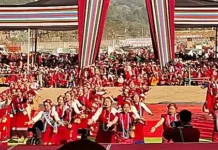[ Inti Pertin ]
In Arunachal Pradesh, even if a child speaks in her native tongue, the moment she is sent to school she immediately picks up Hindi.
The classic example of this is Sunny. Her parents are both Nyishi, but she hardly ever speaks her mother tongue. Like most Arunachalee children, she was sent to a boarding school at a very young age, and that is where she picked up Hindi. After returning home, Hindi is what she spoke in. Her mother, who is a lyricist who writes songs in pure Nyishi, is quite indignant that Sunny, her eldest child, does not know how to speak her mother tongue.
Sunny says that she can understand the basics of Nyishi but is not able to carry on a conversation – and because of constant pokes from her family and relatives because of her inability to speak Nyishi, she says she has lost interest in learning her language. She also points out that her Nyishi is better than most of her cousins’, who she says cannot even introduce themselves when told to do so in family picnics.
She says that a majority of her cousins speak in Hindi or Assamese and think that adding “Um” after every Hindi sentence is their version of speaking Nyishi.
The reason behind this phenomenon of widespread use of Hindi and disregard for the local tribal languages is twofold: the breakaway of Arunachal Pradesh from Assam, and the Sino-Indian Conflict.
Arunachal Pradesh was previously a part of the tribal areas of Assam and known as the North-East Frontier Agency (NEFA). Educational institutions then taught in Assamese. After the violent breakaway – a parting of ways that continues even now – there was widespread opposition to Assamese being used as a mode of instruction, and Hindi and English were introduced.
The use of Hindi was also encouraged due to the presence of the Indian Army during the war between India and China. The Army provided schools and hospitals, so it was imperative for the tribals to learn Hindi.
While the exact reason for the extensive use of Hindi in Arunachal Pradesh is debatable, what is factually known is that most of our tribal languages are on the verge of dying. In a 2017 survey conducted by the UNESCO, 33 languages of the state were listed as endangered, while four were listed as being on the verge of extinction.
Lisa Lomdak, a linguistic assistant professor at Rajiv Gandhi University’s Arunachal Institute of Tribal Studies, says, “The will to learn cannot be imposed if the love for their mother tongue is not nurtured.”
She believes that our usage of local languages is lessening because of various reasons, such as boarding schools, where the parents or relatives are not there to teach the child their mother tongue, and inter-marriages between tribals and non-tribals or the parents being from different tribes. Children growing up in these houses tend to speak or understand their mother tongue even less.
Another reason is working parents who are too tired and find it more convenient to converse in Hindi and watching cartoons. Because of their usage of Hindi, children imitate them and pick up their language and idioms.
The demography of the state is another reason, as 64% of the population is ST, while the remaining 34% is general. The growing flow of migrant workers who speak either Assamese or Hindi is another reason for the wide spread of Hindi and Assamese.
Interestingly enough, Hindi, when spoken by the Arunachalee tribals, becomes ‘Arunachalee Hindi’.
“Arunachal’s tribal languages do not have any distinction between male and female, but Hindi does,” says Lomdak. “So, when Arunachalees speak in Hindi, they speak it with no genders. For example, if a person is speaking to a girl in Arunachalee Hindi, the sentence would be ‘Tum jaarai kya?’ instead of the correct ‘Kya tum jaa rahee ho?'”
Lomdak feels very vehemently when she says, “It is wrong to place the blame solely only the youth for their lack of knowledge about their mother tongue. Itis also the parents’ responsibility to teach and educate their children. All are responsible.”
Nowadays, Arunachalee youths are embarrassed to speak in their mother tongue because they believe it to be inferior. They also do not speak their mother tongue because their inability to speak fluently causes frustration and embarrassment to the speaker.
Lomdak also believes that what makes a language a lingua franca is convenience – the number of people speaking the language, and the number of people in influential positions who speak the tongue.
The languages which are most under threat are the ones belonging to the largest tribes like Adi, Galo,and Nyishi.
Sunny says that, after talking about this issue, she wants to make more effort to learn Nyishi.
Efforts are being made to restore local tribal languages, culture, and history by the government of India as well as the tribes themselves, and written scripts are being introduced or promoted, such as the Khamptis’ Lik Thai and the Wanchos’ Wancha script.
The sole question that stands is, will it be enough?




